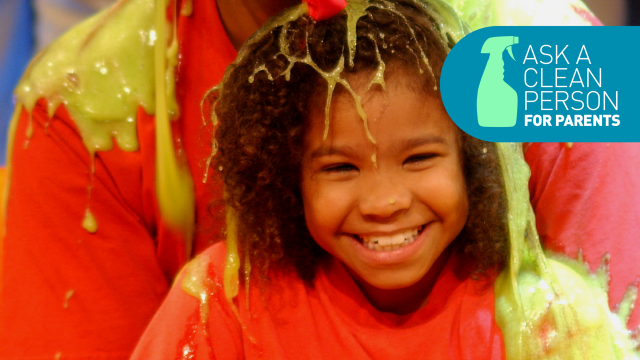Instead of leading with a question, I’m going to summarise a problem that came to my attention recently: What to do when slime gets in your kid’s hair.
Photo: Nick Hotel (Creative Commons)
I’m summarising because the reason this came to my attention is that some parents tweeted a video of their little girl sobbing hysterically as her mum chopped off her bangs, which had gotten covered in slime. The video was terrible, and as that girl cried, I cried – I’m very sensitive! That quality makes me good as an advice columnist but a bit of a wreck as an actual human who has to live in this cruel world.
But! One of my Twitter followers suggested that I write about how to get slime out of hair as a way of turning those proverbial lemons into lemonade, and so I’m going to do that.
Homemade slime, or Flubber, is a mixture of Elmer’s glue, Borax and water. There is also Oobleck, which is made by mixing equal parts cornflour and water. I have very fond memories of playing with Oobleck, because Oobleck is rad, and it should also be mentioned that, as far as the non-Newtonian fluids go, it’s a bit easier to clean up than Flubber, especially if you don’t use food colouring.
The thing to remember with Oobleck is to use cold water to rinse it out of clothes, or hair, or stuffed animals, because starches will get gummy when exposed to hot water.
With that little diversion out of the way, let’s talk about slime.
How to Get Slime Out of Hair
If your kids play with slime, there’s a pretty good chance some of it will end up in their hair. Fret not! There are plenty of ways to get slime out of hair without having to cut that hair off.
Facile as it may sound, start by washing the hair, but do that reverse conditioning thing where you start with conditioner and end with shampoo – the slime may end up washing right out with hot water and conditioner, as many conditioners contain oil, and oil is The Thing to combat slime.
But let’s say a mere washing doesn’t do the trick. You’re still not going to fret because you know that The Thing to combat slime is oil. (You know that because I just told you that.) So! Get some oil – cooking oils such as olive, canola or coconut are great! Mayo works! So does peanut butter! Baby oil? Sure thing! Essential oils, such as lavender or tea tree oils? Yup! Motor oil? Ehhhh … let’s agree that motor oil isn’t the best choice here.
Whatever oil you choose, gently massage it into the be-slimed hair using your fingers, working in the direction of the hair’s growth. The slime should begin to loosen, at which point you can use a comb to coax it out or simply wash the hair.
Getting Food Colouring Stains Out of Hair
If the slime recipe you’re using calls for food colouring, and the slime-coated hair in question is on the lighter end of the spectrum, there may be staining. A pharmacy shampoo such as Tresemmé may strip the colour right out (check this out!), though I’ll mention that when I was trying to de-pink my hair last summer, Tresemmé didn’t do much.
If a cheap shampoo doesn’t do it, try applying rubbing alcohol to a damp washcloth and wiping the hair with it, working in the direction of the growth to avoid tangling.
General Food Colouring Cleaning Tips
Let’s close this out with a quick primer on food colouring: Basically, the same thing applies to fabric, carpet, hardwood, countertops and so on as to hair when it comes to food colouring stains – rubbing alcohol is the stuff to use. On hard surfaces such as floors, walls, counters and so on, Magic Erasers can also be used, just be sure to always test in an inconspicuous spot to make sure the Magic Eraser doesn’t damage the finish of what you’re trying to clean.
If food colouring stains clothing or other textiles that can be flushed with water, what you’ll want to do is this: Apply the rubbing alcohol to the stains and then rub the stained portion of the fabric against itself. Then, hold the stained fabric taut under cold running water and rub it against itself again.
The combination of the rubbing alcohol, agitation of the rubbing, and flushing with cold running water will make quick work of eliminating the staining. (This also works on hair colour, which is helpful to know should temporary, semi-permanent or permanent dye get on something like your pillowcases or shirt collars!)
When it comes to food colouring on things such as carpet or furniture, which can’t be flushed with water, using an old toothbrush dipped in the rubbing alcohol can help to work the stains out. As you work, wipe the area with a light-coloured cloth dampened with a bit of water to wipe away the alcohol and dye; it may take several passes, but the food colouring stains will lift eventually with some patience – and zero tears.

Comments